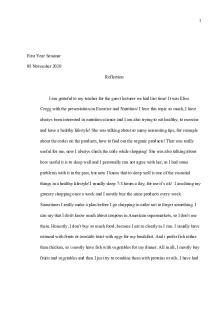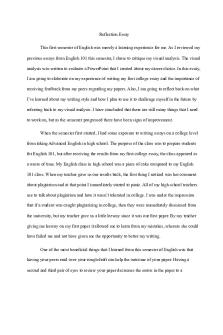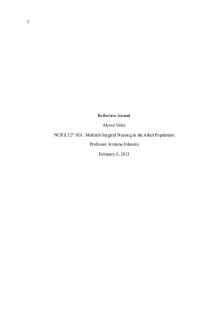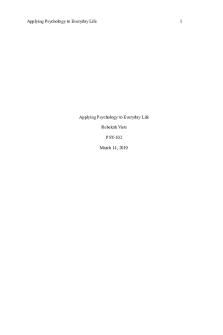A dangerous life - reflection PDF

| Title | A dangerous life - reflection |
|---|---|
| Course | Environmental Health |
| Institution | James Madison University |
| Pages | 5 |
| File Size | 46.6 KB |
| File Type | |
| Total Downloads | 114 |
| Total Views | 170 |
Summary
reflection...
Description
Brianna Centro Years of Living Dangerously: A Dangerous Future In the continuation of watching Years of Living Dangerously, heat waves along with floods, cyclones, and other extreme weather events all over the world are causing devastation (A dangerous future, 2014). In addition to this aspect of the episode, climate change and its effects on extreme weather are hurting vulnerable and developing countries the most who can’t adjust to these dramatic events as they exacerbate (A dangerous future, 2014). It appears that even though the industrialized nations are causing long-term climate impacts, less developed countries are the ones who are suffering from secondary effects while the US is especially suffering from prolonged heat. As the episode begins (A dangerous future, 2014), it’s made evident that the amount and magnitude of heat waves are going to increase dramatically, having substantial social, health, and economic impacts. “Heat waves, which are prolonged spikes in temperature, bring with them all sorts of health consequences,” (A dangerous future, 2014, 3:20) which means that as the heat waves are expected to increase, it makes sense that health consequences will as well. According to Nadakavukaren (2011a), in the United States alone, the temperature is higher than the world average and has risen by 2° F in the last half-century, with the cause for warming being increased atmospheric carbon dioxide levels. It appears to be a vicious relationship between the US emitting large amounts of carbon dioxide through ignorant human and in turn warming our atmosphere, which results in an increase in mortality and morbidities for us. In Los Angelis, California, poor neighborhoods are suffering the hardest from the heat since poor neighborhoods tend to have less trees which means less heat can be absorbed by the leaves of trees and less carbon can be absorbed, which creates a cooling effect
(A dangerous future, 2014). This is just one example of a highly populated area where heat is impacting certain groups at a more intensified rate. Rupa, a worker from the EPA of California showed that in relation to these heat increases in California from lack of plants and trees, she noticed pregnant women specifically being impacted (A dangerous future, 2014). It is important to note that CO2 doesn’t have a direct adverse effect on health, but that increased levels of global climate lead to increased heat (Nadakavukaren, 2011 A), which in turn leads to symptoms like dehydration. When these women are experiencing long-term heat in susceptible areas like LA, dehydration prompts early contractions that can then initiate premature births (A dangerous future, 2014). It appears that climate change isn’t directly affecting health, but indirectly affecting health of these poor individuals more than others and even the future health of babies born in this extreme heat. Rupa was able to calculate that due to the last heat wave in LA, there were 170 excess deaths compared to time periods outside this 5 day span (A dangerous future, 2014). This is alarming because according to Nadakavukaren (2011a), by the end of this century, what the US considers as “very hot” days are expected to be 10° hotter than that. It appears that the death toll in Los Angelis for just one heat wave is a mere projector for deaths due to heat waves in the future and the larger population at hand. The next part of this episode (A dangerous, future, 2014), Matt Damon visits Yemen, a country in the Middle East in which rains used to be rare, but where rain is becoming very strong and devastating when it occurs. This unexpected increase in the frequency and intensity of precipitation is due to climate change because as the planet warms, evaporation rates increase and so do precipitation rates consequently (Nadakavukaren, 2011 A). Yamen could be the first country in the world to run out of water completely, with individuals coping
with less than 300 cubic meters of water supply per person per year (Nadakavukaren, 2011 B), which appears to be much below developed countries and not adequate for the population at hand. Yamen has just a portion of the 40% of the world’s people that are experiencing water “stress,” meaning that they have to deal with less than 1700 cubic meters of water per person annually. They are even considered to be victim to “acute scarcity,” having below 500 cubic meters of water per person annually, insufficient for food production and sometimes inefficient for adequate sanitation (Nadakavukaren, 2011 B). Taiz city, the second biggest city in Yemen, is expected to be the first to run out of water, having to wait 30-40 days only to get water for 1-2 days, and must purchase water from tankers at a very high cost in between (A dangerous future, 2014). This does not appear to be surprising for most urban areas water supply systems are in place, but could only function for a few hours and require waiting in line or is an expensive purchase (Nadakavukaren, 2011 B). In relation to the struggles in Yamen for water, Bangladesh is yet another country suffering from climate change with migration, water, and intensified weather problems. In Southern Bangladesh, 150mph winds during cyclones have become bigger, stronger, and more frequent with expectations of 17% of landmass to be inundated and 20 million people to be forced off land because of water by the end of this century (A dangerous future, 2014). These factors are leading “climate migration” which is the move to other places because of climate, causing people close to the water in Southern Bangladesh to move inward to the capital of Dhaka, a very urban area (A dangerous future, 2014). It’s expected that by 2030, over ½ of the developing world’s population will live in urban areas and 2/3 of these people will be city dwellers (Nadakavukaren, 2011 C). It appears that this phenomenon is foreshadowed by the move from climate-affected areas to cities like Dhaka. Dr. Omar Rhamen from the University of Bangladesh, who is also an expert
in demography, says that Dhaka is the 6th largest and fastest growing megacity in the world with expectations of the population to double in the near future (A dangerous future, 2014). A megacity is any urban area with a population of 10 million or more, which puts pressure on the government’s ability to provide basic services and those services are expected to lag as populations continue to expand (Nadakavukaren, 2011 C). Since climate is causing so many people to migrate from their homes to Dhaka per day, it’s going to continue result in inability of the country to support them and therefore poor living and health conditions. Luckily, there are people fighting for migrant’s rights in Dhaka, where some migrants are working for less than 2 dollars a day with poor working and living conditions to add to it (A dangerous future, 2014). Unfortunately, a large number of these urban dwellers that have migrated from other areas come to the megacity in hopes for a more comfortable life and a job, but often lack education and skills so they are deemed incapable of contributing to the economy (Nadakavukaren, 2011 C). It seems that this population is targeted for jobs with these uninsured companies because they’re so desperate to make a living, they’ll accept whatever work they can find.
References: A Dangerous Future (2014): Years of living dangerously. Films On Demand. Films Media Nadakavukaren, A. (2011 A). The atmosphere. In Our global environment (7th Ed.) (pp.
281-312). Long Grove: Waveland Press, Inc. Nadakavukaren, A. (2011 B). Water resources. In Our global environment (7th Ed.) (pp. 395-416). Long Grove: Waveland Press, Inc. Nadakavukaren, A. (2011 C). Population dynamics. In Our global environment (7th Ed.) (pp. 33-54). Long Grove: Waveland Press, Inc. Group. Web. 27 January. 2016....
Similar Free PDFs

A dangerous life - reflection
- 5 Pages

A Dangerous Son - Prof. Schenk
- 7 Pages

Reflection Essay - Grade: A
- 2 Pages

Final Reflection - Grade: a
- 3 Pages

Reflection 2 - Grade: A+
- 2 Pages

Reflection nutrition - Grade: A
- 3 Pages

Injustice: A Reflection
- 3 Pages

Dangerous Goods 100 questions
- 6 Pages

Reflection - Grade: A
- 5 Pages

Reflection essay - Grade: A
- 3 Pages

Reflection 2- Part A
- 2 Pages

Reflection Journal - Grade: A+
- 2 Pages

A Life saving Station
- 1 Pages

A Radically Fearless Life
- 1 Pages
Popular Institutions
- Tinajero National High School - Annex
- Politeknik Caltex Riau
- Yokohama City University
- SGT University
- University of Al-Qadisiyah
- Divine Word College of Vigan
- Techniek College Rotterdam
- Universidade de Santiago
- Universiti Teknologi MARA Cawangan Johor Kampus Pasir Gudang
- Poltekkes Kemenkes Yogyakarta
- Baguio City National High School
- Colegio san marcos
- preparatoria uno
- Centro de Bachillerato Tecnológico Industrial y de Servicios No. 107
- Dalian Maritime University
- Quang Trung Secondary School
- Colegio Tecnológico en Informática
- Corporación Regional de Educación Superior
- Grupo CEDVA
- Dar Al Uloom University
- Centro de Estudios Preuniversitarios de la Universidad Nacional de Ingeniería
- 上智大学
- Aakash International School, Nuna Majara
- San Felipe Neri Catholic School
- Kang Chiao International School - New Taipei City
- Misamis Occidental National High School
- Institución Educativa Escuela Normal Juan Ladrilleros
- Kolehiyo ng Pantukan
- Batanes State College
- Instituto Continental
- Sekolah Menengah Kejuruan Kesehatan Kaltara (Tarakan)
- Colegio de La Inmaculada Concepcion - Cebu

